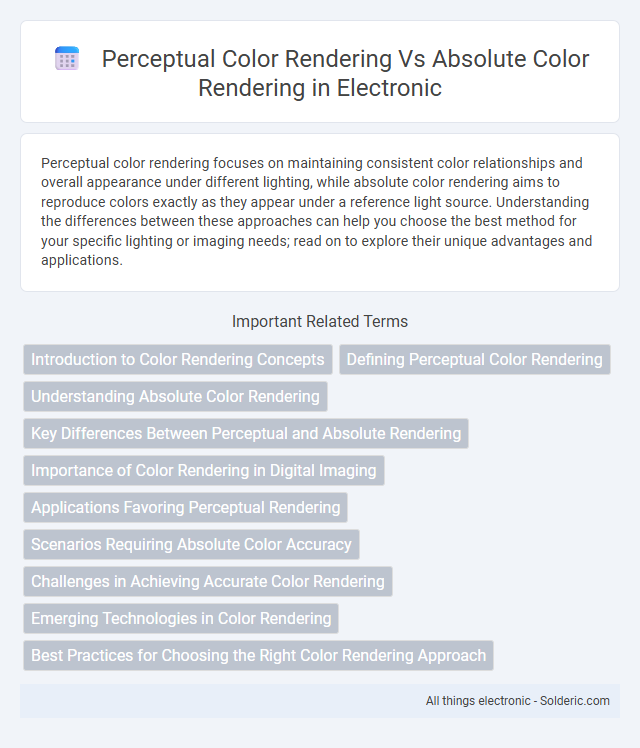Perceptual color rendering focuses on maintaining consistent color relationships and overall appearance under different lighting, while absolute color rendering aims to reproduce colors exactly as they appear under a reference light source. Understanding the differences between these approaches can help you choose the best method for your specific lighting or imaging needs; read on to explore their unique advantages and applications.
Comparison Table
| Aspect | Perceptual Color Rendering | Absolute Color Rendering |
|---|---|---|
| Definition | Focuses on how colors are perceived relative to surrounding colors under different lighting conditions. | Measures exact color matching of objects under a light source compared to a reference illuminant. |
| Color Accuracy | Prioritizes visual harmony and overall appearance. | Prioritizes precise color fidelity and exact color reproduction. |
| Application | Used in design, art, and visual perception studies where color impression matters. | Used in quality control, manufacturing, and fields requiring standardized color accuracy. |
| Measurement Metrics | Involves models like CIECAM02 emphasizing color appearance. | Uses metrics like CRI (Color Rendering Index) and CQS (Color Quality Scale). |
| Lighting Impact | Accounts for contextual lighting and human visual adaptation. | Compares direct light source color output against reference illuminants. |
Introduction to Color Rendering Concepts
Color rendering evaluates how accurately colors appear under different light sources, with perceptual color rendering emphasizing human visual perception and the naturalness of colors. Absolute color rendering focuses on precise replication of colors under a reference light, prioritizing physical accuracy over subjective experience. Understanding these concepts helps you choose lighting that balances color fidelity and visual comfort for various applications.
Defining Perceptual Color Rendering
Perceptual color rendering refers to the evaluation of light sources based on how the human eye perceives colors under those lights, emphasizing color appearance and subjective visual experience rather than exact spectral matches. Unlike absolute color rendering, which assesses color accuracy by comparing spectral power distributions directly, perceptual color rendering prioritizes how natural and vivid colors look to observers in real-world environments. This approach accounts for factors such as ambient lighting, viewing conditions, and human visual system characteristics to provide a more holistic understanding of color quality.
Understanding Absolute Color Rendering
Absolute color rendering measures how accurately a light source reproduces colors compared to a reference light, ensuring true color fidelity without distortion. This metric relies on standardized color samples and scientific evaluation, making it essential for industries demanding precise color identification. Understanding absolute color rendering can help you select lighting solutions that preserve the integrity of natural colors in retail, art displays, and manufacturing.
Key Differences Between Perceptual and Absolute Rendering
Perceptual color rendering preserves the visual relationships between colors to maintain overall appearance, adapting colors when the original gamut exceeds the target device's capabilities. Absolute color rendering aims to reproduce colors exactly as they appear under a reference illuminant, maintaining color accuracy without adjusting spatial relationships. The primary difference lies in perceptual rendering's adaptability for visual consistency versus absolute rendering's focus on precise color matching.
Importance of Color Rendering in Digital Imaging
Color rendering in digital imaging is crucial for accurately reproducing hues and shades, ensuring images appear natural and true to life. Perceptual color rendering prioritizes visual consistency by preserving relational color differences across various lighting conditions, enhancing your viewing experience. Absolute color rendering, by contrast, focuses on exact spectral match, which is essential for critical applications requiring precise color identification.
Applications Favoring Perceptual Rendering
Applications favoring perceptual color rendering include digital imaging, virtual reality, and artistic photography, where maintaining the subjective visual experience is essential. This approach prioritizes human color perception and adapts color reproduction to preserve extended details and natural appearance under varied lighting conditions. Perceptual rendering enhances user engagement and realism by offering visually consistent images across diverse display devices.
Scenarios Requiring Absolute Color Accuracy
Scenarios requiring absolute color accuracy include medical imaging, art restoration, and product quality control, where precise color representation is critical for diagnosis, authenticity, and consistency. Absolute color rendering ensures that colors match their real-world counterparts exactly by using calibrated lighting and measurement tools, eliminating perceptual deviations caused by ambient conditions or observer differences. In these fields, relying solely on perceptual color rendering can lead to misinterpretations and errors due to subjective variations in human color perception.
Challenges in Achieving Accurate Color Rendering
Achieving accurate color rendering faces significant challenges in balancing perceptual color rendering, which focuses on how colors appear to the human eye under varying conditions, against absolute color rendering that demands precise spectral fidelity. Variabilities in light sources, observer conditions, and material properties complicate the ability to maintain consistent color appearance across different environments. Advanced colorimetric models and calibration techniques are essential to address metamerism and spectral mismatches inherent in both perceptual and absolute approaches.
Emerging Technologies in Color Rendering
Emerging technologies in color rendering are advancing both perceptual and absolute color rendering methods to achieve more accurate and visually appealing lighting solutions. Perceptual color rendering leverages adaptive algorithms and AI to better mimic human visual responses, enhancing how colors appear under varied lighting conditions. Your lighting design can benefit from these innovations by improving color fidelity and consistency in applications like augmented reality and high-definition displays.
Best Practices for Choosing the Right Color Rendering Approach
Choosing between Perceptual Color Rendering and Absolute Color Rendering depends on the application's need for color accuracy versus visual consistency. Perceptual Color Rendering is best for scenarios where maintaining the natural appearance of images under varied lighting is crucial, such as in photography or video production, while Absolute Color Rendering suits applications demanding precise color matching, like product design and printing. Understanding your project's color fidelity requirements ensures you select the optimal approach to preserve your visual integrity.
Perceptual Color Rendering vs Absolute Color Rendering Infographic

 solderic.com
solderic.com